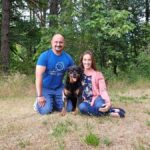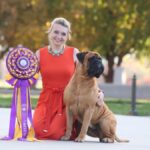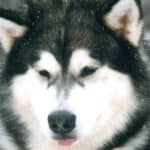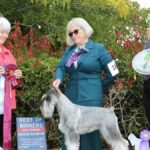Interview with Joan Savage, Breeder of Stagedoor English Setters
- Please tell us a little bit about yourself. Where do you live? How many years in dogs? How many years as a breeder? What is your kennel name?
- What is your “process” for selecting show puppies? Performance puppies?
- In your opinion, is your breed in good condition overall? Any trends that warrant concern?
- As a Preservation Breeder, can you share your thoughts on the sport today? How’s the judging these days? What do you think about the number of shows?
- In your opinion, is social media good for the sport? Is it harmful?
- What are the biggest challenges facing the dog show community as a whole today and how can these be addressed?
- What are some of the positive changes you’ve seen in the sport over the past decade?
1. My name is Joan Savage and I have bred English Setters since 1982. I am a retired veterinary technician, so I am very conscious of having healthy, hardy breeding stock. We are very lucky to have the OFA database to check on clearances of possible stud dogs. My kennel’s name is Stagedoor English Setters. I am an AKC Breeder of Merit and have bred over 100 champions. I have bred several National Specialty winners, BIS, and BISS winners. I was honored by the AKC by winning the Breeder of the Year award in 2008. I also currently judge the Sporting Group, Junior Showmanship, and BIS. I grew up in Cincinnati, Ohio, but I have been living in the Portland, Oregon, area since 1980. We have 11 acres in a rural area 30 minutes from Portland. I belong to the Portland KC, and I’m their Delegate, Dog Fanciers Assoc. of Oregon, Tualatin KC, ESAA, and I am the President of the Willamette Valley English Setter Fanciers.
2. When I have a litter, I am watching and handling the puppies from birth. Then, I officially grade them at eight weeks, taking photos and looking at them with a very critical eye. At that age they are pretty balanced and look like little setters. They have to pass the BAER hearing test, have a good bite, and the testicles should be dropped by then. As for performance, their hunting instinct should be evident, by noticing birds and butterflies in the yard. Most do this naturally. I have put Junior Hunter titles on several of my dogs, though I have not had the time to go further in the hunting levels.
3. My opinions of the show trends in English Setters is that most setters are happy and good-tempered for the ring. This makes them fine for novice and owner-handlers to be successful. Grooming has become an art form. Generally, breeders have bred for excessive coat. When judging, I look for a healthy texture, not focusing on too much furnishings. Fronts are generally lacking in angle and depth, and often, not in balance with the rear angle. The setters should be balanced front to rear, with enough leg for length of body. I would also like to see more classic headpieces, which should be elegant with level, parallel planes of equal length and a moderate stop.
4. I believe the sport in general has declined. The number of dogs entering is low, with the same dogs every weekend. No class dogs, all Specials. Breeders are aging and not breeding as often. The social pressure on breeders has affected the public buyers’ opinions of purebred dogs. I find that I have to defend what I do to the general public. I find that the judging of my breed is hit or miss. Too many newer judges just check the boxes without learning the nuances of the breed. Judging larger entries at Specialties, the judges generally find the better dogs, but with small entries they often find the flashy, showy dogs, not always the best English Setter.
5. I think social media has been good and bad for the sport. There are sometimes too many harsh negative comments, but it is helpful to spread needed information quickly. I also find social media is fun for bragging about wins and keeping up with my puppy buyers.
6. I believe the biggest problem with the sport today is the aging of breeders and club members. The younger generation doesn’t seem to be big on joining clubs or to get serious about breeding. They like to show, but they don’t volunteer to join the clubs or work to host the shows. There still may be a possibility of encouraging young participants from within the 4H community.
7. I find one of the positive changes in the sport is the addition of the Grand Champions. People are encouraged to keep showing to earn more titles, and there are many new events to compete in. The downside is that they keep showing the same dogs and they aren’t starting with a new or younger dog. Hence, most entries at the shows are in Specials and not in the classes. With that, the point scale keeps dropping, making it easier to finish dogs.








